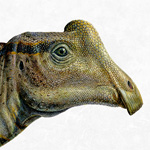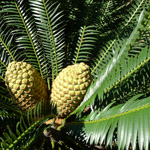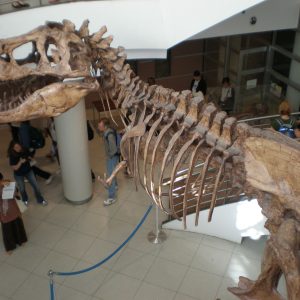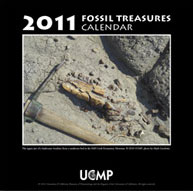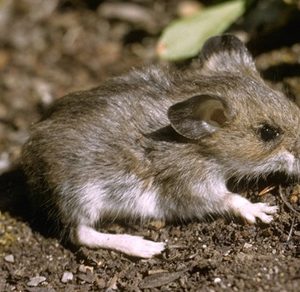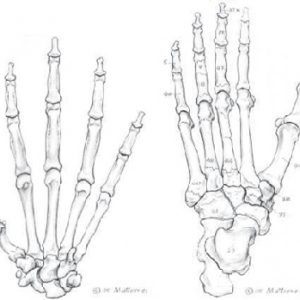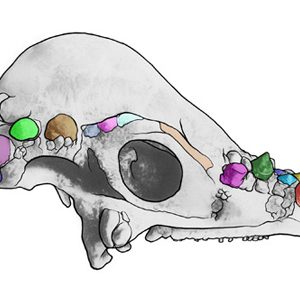Recent Ph.D. grad Sarah Werning, now in a postdoctoral position at the State University of New York at Stony Brook, was a major contributor to a paper released today on ontogeny in Parasaurolophus, a Cretaceous hadrosaurid dinosaur notable for the hollow, bony tube on its skull. The study centers around a remarkable skeleton of a baby Parasaurolophus (nicknamed "Joe") discovered in 2009 by Kevin Terris, a student at The Webb Schools in Claremont, California, in exposures of the … [Read more...] about Werning co-authors paper on growth in Parasaurolophus
Cycads: Not the “living fossils” that we thought
Palm-like cycads have been around since the last dinosaurs munched on them 65.5 million years ago, but those that we see today are really only a few million years old, according to a new study by an international team of scientists. “Cycads are poster-child living fossils, yet the living species are really young,” reports UCMP Director and Professor of Integrative Biology Charles Marshall, co-author of the study appearing online October 20 (in advance of publication) in Science. “So, while the … [Read more...] about Cycads: Not the “living fossils” that we thought
125,000 years of geologic change in SF Bay, not much change in the microfauna
San Francisco Bay has had a dynamic and complex history over the past million years as sea level rose and fell at least four times with alternating warming periods and glaciations. About 13,000 years ago, the first group of humans arriving in the area would have walked through a valley with a river flowing nearly 48 km out toward the ocean. The current bay formed only about 6,000 years ago. In a recent paper published by Quaternary Research, Amy Lesen, former PhD student in UCMP and currently … [Read more...] about 125,000 years of geologic change in SF Bay, not much change in the microfauna
Congratulations to Mark Terry
Mark Terry, a long time Teacher Advisor to UCMP, is the recipient of the 2011 Evolution Education Award, an annual award sponsored by AIBS and BSCS. Mark is a high school Biology teacher at The Northwest School in Seattle. I first met Mark in 2000 when he sent an email inquiring about a conference that we were hosting — The National Conference on the Teaching of Evolution. The conference served to bring together members from professional societies to examine what their roles might be in … [Read more...] about Congratulations to Mark Terry
The Opportunistic T. rex
Looks like the tyrant lizard wasn't so scary after all. UCMP's Mark Goodwin and Jack Horner, curator of paleontology at the Museum of the Rockies, have been working in the late Cretaceous Hell Creek Formation of Eastern Montana for decades, an area famous for its impressive fossil assemblages including fish, mammals, and dinosaurs like Tyrannosaurus rex. Based on a census of predator and prey found at several of the time intervals represented in the Hell Creek Formation, Goodwin and Horner … [Read more...] about The Opportunistic T. rex
National Fossil Day at UCMP
Yesterday was the first ever National Fossil Day and UCMP pulled out all the stops! Come check out the new online exhibit, Fossils in our parklands: Examples of UCMP service and stewardship, featuring fossils in UCMP's collection from national and state parks in California, Nevada, Oregon, and Montana. The museum played a pivotal role in the creation of some of the featured parks and we're happy to highlight our shared histories. Additionally, the 2011 UCMP Fossil Treasures Calendar is now … [Read more...] about National Fossil Day at UCMP
Global warming and declining mammal diversity: new research in Nature
Popular images of Ice Age California tend to feature enormous, extinct mammals like mammoths and saber-toothed cats. By contrast, new research published in Nature examines populations of small mammals that survived through the end of the Ice Age and how they were affected by the climate change. The research team of Jessica Blois (formerly at Stanford, now at University of Wisconsin, Madison), Elizabeth Hadly (formerly of UCMP, now at Stanford) and Jenny McGuire (UCMP) studied fossilized … [Read more...] about Global warming and declining mammal diversity: new research in Nature
Ardi is Breakthrough of the Year
Ardipithecus ramidus has been named Science magazine's Breakthrough of the Year. At 4.4 million years old, Ardi is the oldest hominid skeleton. This fall, a series of 11 papers about Ardi and her paleoenvironment were published in Science. UCMP Faculty Curator and Human Evolution Research Center (HERC) director Tim White was one of the lead scientists on the project, which involved an international team of researchers, including UCMP Faculty Curator Leslea Hlusko. To learn more about Ardi, … [Read more...] about Ardi is Breakthrough of the Year
Paleo Video: A modern day dinosaur extinction
During the Cretaceous, dome-headed pachycephalosaurs roamed through what is now the Hell Creek Formation, covering parts of Montana, Wyoming, and North and South Dakota. But UCMP Curator Mark Goodwin and Museum of the Rockies Curator Jack Horner argue that there were fewer pachycephalosaur species than we thought. Mark and Jack suggest that two species, Dracorex hogwartsia and Stygimoloch spinifer, are actually juveniles and teenagers of the species Pachycephalosaurus wyomingensis. Learn about … [Read more...] about Paleo Video: A modern day dinosaur extinction
